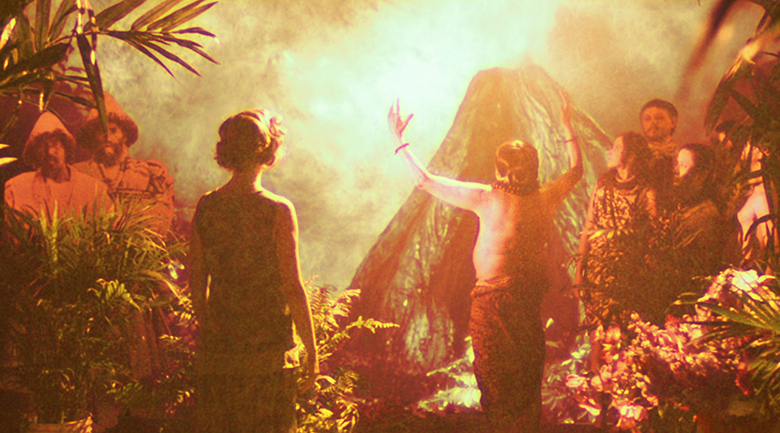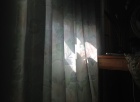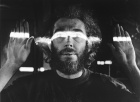With eleven features and innumerable short films to date, Winnipeg-based filmmaker Guy Maddin has delighted and confounded audiences with his work over the last three decades. The idiosyncratic director, whose unmistakable style recreates the aesthetics of the late silent and early sound periods of cinema, has earned the Order of Canada and won numerous international and domestic awards, and will soon take a position as a Visiting Lecturer at Harvard University.
Over the last five years, Maddin has obsessed over remaking lost and unrealized films from cinema’s early decades, a period from which only a small fraction of films survive. This project yielded a series of installations under the names Hauntings and Séances, as well as the forthcoming feature The Forbidden Room (2015). The Forbidden Room has a nesting box-style narrative which fits lost film inside lost film. A related forthcoming project is a website hosted by the National Film Board, which will take pieces from almost a hundred of these lost and remade films to create a unique film for each viewing, with a randomly generated title. The film will then itself be lost.
On July 22, Maddin visited the Banff Centre to speak about his recent work and screen several clips from The Forbidden Room. I spoke with him a week later by phone from his home in Winnipeg.
Murray Leeder: I’d like to hear you talk about this term “ectoplasmovision” that you used in Banff [to describe your techniques in The Forbidden Room].
Guy Maddin: Well, that was a term that I clumsily attempted to coin last Wednesday night. I’ve only said it once. It doesn’t quite add up to something I’d certify as a trademark or anything like that. Ectoplasmovision, or... ectovision, maybe?
When you photograph something, you might as well be firing the starting pistol on a great race between the actual living thing you photographed and the photographic record of it, as they race away from each other in time. They age at the same rate, but one of them is frozen in some emulsion or some pixels and the other one’s aging, biodegrading, and so inevitably, with enough time passing, the image frozen looks much different than the thing photographed. It looks eternally young, while the subject ages. Eventually you’re forced to conclude that what’s recorded by the camera is some sort of, at least metaphorically, a ghost of something that was once as it appears in the picture but is no more. And so that’s why film has been called “the haunted medium” more than any other art form.
And that, combined with the use of the word “séance,” which means a seating [in French], being appropriated by the paranormal to describe a seating intended to make contact with spirits, you have a whole concept that’s doubly reinforced by paranormal overtones. And triple reinforced when you’re obsessed with lost films, with ghosts you can no longer have access to and project. You’re haunted by their memories, which is what ghosts really are anyway.
I don’t happen to believe in ghosts, so I think of ghosts as memories. Hamlet’s father’s ghost in the play is some sort of really extra-felt memory of the father, so much so strongly felt that even guards are seeing him, not just the son. And so, when trying to put on the screen my own desires to see these lost films, it’s a kind of a wishful thinking strong enough to not only see ghosts but to actually make them happen. Kind of like what a lot of mediums who ended up as charlatans but probably started out as strongly desirous of making contact with real spirits.
I’m thinking of Thomas Glendenning Hamilton, who was in the ’20s a member of the legislature in Manitoba and the head of the Manitoba Medical Association, who lost a son in World War I, and wanted to make contact with his dead son. But somewhere along the way, crossed over into mountebank territory and started hosting in his house séances, which were clearly the work of charlatans. And so somewhere along the line, he started out as grief-stricken father, dying to see his own son again, and ended up perpetrating a bunch of hoaxes. Much like movie directors just start out wanting to make something really wonderful, put something of themselves up on the screen, and end up being a bunch of corrupted frauds! It sure feels like there are enough forces steering you in that direction during the long course of a career, anyway. So filmmaking and ghost-creating, and ghost-busting, and all those things seem to be one and the same thing to me.
ML: Do you imagine “ectoplasmovision” as one long word, or with hyphens?
GM: I sort of deleted it from my memory after attempting to coin the term. It seems to have a couple of extra syllables in it. Well, a lot of times when there’s “o” in the middle of a word like that, there’s a hyphen on either side of the “o.” Ectoplasm-hyphen-o-hyphen-vision.
ML: It makes it sound like a William Castle gimmick.
GM: And maybe the “ect” could have a “k!”
ML: Ektoplasm-o-vision! Staying with ghosts, you staged séances on the set for The Forbidden Room?
GM: Yeah, everyday, we held a séance at the start of the day. It was at a weird hour. It was never at midnight or when it was dark out. It was at the start of a workday. Sometimes as late as noon. We would lower the lights on the set and just calm the actors, try to put them all in the same state of mind just by listening to my voice. My woefully inadequate voice. But almost like an acting exercise, I would just calm them, get them ready for the day’s performance, get them to open up, open to receive the will of the long lost narratives. They’re also just opening themselves up to my will and also to just the possibility, all the sorts of possibilities that actors are always in contact with when they’re at their most open. The kind of thing you want of them anyway.
It’s a matter of almost hypnotizing them verbally and then just getting them slowly massaged in the narrative footprints that they’d be following throughout the course of the day. At first they’re almost dozy sleepwalkers half-aware of what they’re doing and then finally, once the warm-ups were complete, it took about ten or fifteen minutes—start the day with these trancelike séances, then things are going full-bore. We didn’t bother ending the day with a slow return to consciousness. I basically just told everyone it was time to go home when 6 o’clock hit.
When you photograph something, you might as well be firing the starting pistol on a great race between the actual living thing you photographed and the photographic record of it, as they race away from each other in time
ML: You mentioned not believing in ghosts. Have you ever attended a spiritualist séance?
GM: No. I went to a Black Mass once, in Toronto. That’s the closest thing to something of this sort, namely something I was exceptionally skeptical about. It was pretty strange, and I found myself wondering how much of any it any of the people there believed in it, but it seemed like at this Black Mass, people were taking it pretty seriously. So I just played along. It was kind of chilling. There weren’t sacrifices of any sort. Just a lot of seeds being spilled eastward. But these séances are more harmless. I kind of believe in collective will and the spirit of a room, or just ambience, collective hallucinations, stuff like that. Not even necessarily anything mystical. It’s the way the human mind works. So I didn’t feel I was insulting my own intelligence by conducting them.
ML: These lost films that you’re remaking ultimately find a home on the Internet. Is the Internet a haunted or haunting space in its own right?
GM: It seems to be a space no one quite understands. It reminds me a lot of some sort of afterlife: a space that doesn’t really seem to exist in the three dimensions that we know, and so it does kind of remind me of that. It seems that we allow and encourage and need the visitations we spend our lifetimes now looking at. So it seems like the proper place. But it also seems like a place where it’s promised data will last forever. But we’re making films out of lost film material and then promising to lose them again. So we’re trying to actually haunt the Internet a bit more than it already is . . . It’s just the promise that the Internet has of storing things forever that almost promises the kind of immortality that an afterlife does, or that’s impossible. And so introducing intentional data destruction online intrigues me.
ML: I’d be hard-pressed to think of a filmmaker who’s more consistently interested in the ghost and haunting than you. But it seems like this move to remake lost films is sort of a step forward from the more personal kind of haunting represented in your earlier films. Did you conceive that as a logical transition?
GM: Yeah. There was so much personal investment in my earlier films, that were about things that haunted me. And while these [lost] films haunted me, not in personal ways. I’ve had varying degrees of luck with getting the experience of my personal ghosts up on screen. I think I did okay with my movie Cowards Bend the Knee (2003), maybe My Winnipeg (2007), a little less so with Brand Upon the Brain (2006), and I seem to fail entirely with Keyhole (2011). And that’s the film I cared the most about. So just because you care a lot about the ghosts that are haunting you, that particular subject doesn’t mean the film you make will succeed in getting those ghosts up there on the screen. So it’s the same thing with these lost films. Even though I don’t have as much personal investment in them. Although every now and again I find these little rhymes of my own life in the stories that I’m telling. I tried to make sure when we edited the things that we stressed the plausible, melodramatic psychology. What seems to be the psychologically true, the most poetically or emotionally true, I tried to stress those storylines. But lots of times just whatever came out, came out. And we’ll see how haunted they seem once they’re all jumbled together on the interactive.
ML: Just to be clear, when you talk about the failure of Keyhole, was that a failure to actualize your own conception for the film on screen?
GM: Even watching it alone, I was quite disturbed or troubled by it. It felt good, but I think that’s because I made myself very vulnerable while working on it in the years beforehand. And I think I was just fragile and I lost objectivity, and I forgot to involve the audience in it. So there’s a couple of failures. There’s the failure to connect for an audience, ‘cause I really wanted to bring people into my world and into my experience of being haunted by a home I really loved, or by the feeling I get when I realized I was the person haunting that home myself in my dreams. And I just failed. Like I put out a big unwelcome mat in front of the house . . . So I made a point when working on The Forbidden Room to really do shoulder checks and make sure I hadn’t lost the viewer. I made very frequent ones. I wanted everything to be as clear as possible so people could come along for the ride. I knew the ride would be exhausting, but I wanted people to process it if they wanted to be able to.
ML: On a different topic, I Googled “Maddinesque” this morning...
GM: Oh, I’ve never done that.
ML: I got about 10 000 hits. And somebody added it to urbandictionary.com in 2004.
GM: And it’s not referring to John Madden? Bellowing, coaching from the sidelines...
ML: The ones at the top were about you for sure. Like “Hitchcockian” or “Chaplinesque,” if someone says “Maddinesque,” it suggests a set of expectations for a kind of style.
GM: Yeah, yeah. I guess so.
ML: And I’m curious, do you ever find yourself going out of your way to be Maddinesque, or the opposite?
GM: I suppose I have my comfort zone, so I’m often not comfortable until things are a certain way. But I have viewing habits that would surprise people for being not Maddinesque in the dictionary sense of the word. And I’m hoping to extend the boundaries of the definition a little bit. But I guess the thing I really have to look out for, is when I have often very keen and wonderfully generous crew members who want to make my own movies more Maddinesque, when they’re thinking more of a 2004-vintage of Maddinesque, and I’d like to keep moving forward. It’s so touching to see someone who’s actually trying to hold me back out of some sort of admiration, but it’s actually like they’re presenting an imitation. Sometimes a convincing imitation of a certain vintage. It gets bad when people misinterpret what is Maddinesque and quite often I’m given ideas that relate more closely to steampunk than something I’d be interested in. I’ve got to be very careful, because the people have often worked hard on their own on the side, and they presented something to me that’s very Maddinesque, and it’s something I’m not really interested in.
ML: What will your next project be?
GM: I’m not sure right now. If you’d asked me a few months ago, I’d have told you one thing, because I was pretty far along the treatment with Evan [Johnson]. We’re going to work together again, and [production designer] Galen Johnson, and hopefully [editor] John Gurdebeke, and all my tight collaborators. I really like working with them. It’s really healthy the way we argue things first, and nothing gets personal. I can only steal from David Lynch right now. It’s a story about a woman in trouble, or something like that. I don’t really have much to say about it. I may have abandoned that project, but I do want to make a story about a woman in trouble. But I’ve got to take most of the next year off to teach, out of town, alas. But thanks for asking. Thanks for your interest. And in about a month, I’ll be in Harvard, picking up an instructor’s ID card and filling out some tax forms and stuff. And then I’ll spend the fall touring around to Paris and London and Toronto and Montreal and New York for various releases of The Forbidden Room.
ML: I look forward to seeing it in its full form.
GM: That’d be great. We just trimmed it down to just under two hours, so it’s nice and brisk and lean. Even its most enthusiastic supporters at earlier festivals this year felt it was a bit too long. I think that’s been taken care of, so I’m hoping that some people like it.





